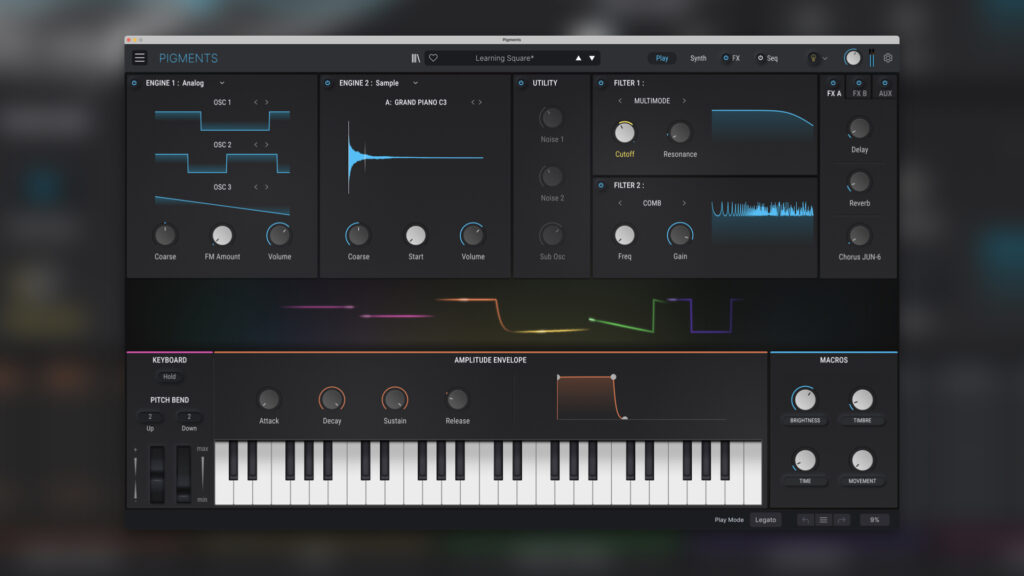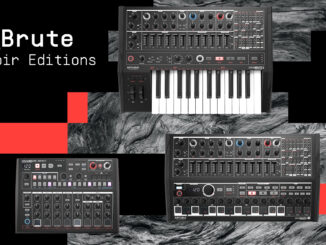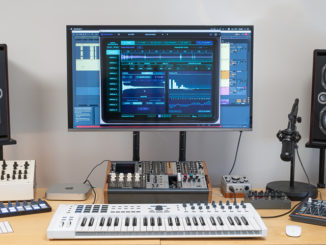Arturia Pigments 4 is a major free update with an all-new user black/white user interface, engine refinements, MS-20 filter, and new effects
Arturia has another highlight before the end of the year. After the release of the MiniFreak hardware Synthesizer in October and the matching freak plugin version at the beginning of December, there is now Pigments 4.
With Pigments 4, Arturia’s popular multi-engine Synthesizer plugin gets a free major update. Packed with new features, improvements, and fresh sound content.
Arturia Pigments 4
Pigments is a Synthesizer plugin powered by a sophisticated and creative multi-engine hosting various synthesis forms. Including fully-customizable wavetable synthesis, esoteric additive sound generation, classy virtual analog, and advanced granular sampling.
The tempo that the Arturia developers have here is remarkable. In April 2021 the release of P3 with the crazy additive synthesis and 8 months later the 3.5 update with cross-mod, new distortions, and more. That was almost exactly a year ago. Pigments 4 is now available for download and users can expect many exciting new features and improvements.
Let’s start with the most obvious, the user interface. This has been reworked and comes with many optimizations for quicker, more intuitive, and enjoyable sound exploration. You can now choose between black and a new fresh white look. New, yes, but I’m sticking with the classic black design.
It also comes with the “Play Mod“, a new alternative user interface with a simplified overview of your entire sound. It has all the stripped-back modules and hands-on macros.
Refined Engine, New Filters, and Effects
A major Pigments does not come without engine improvements. And yes, Pigments 4 also has some new things to offer. It comes with tweaks and improvements on all its mighty engines. For example, the wavetable engine now benefits from an additional ring mod and the phase now has a pulse width mode.
The additive aka harmonic core has been upgraded with phase modulation and the option to randomize the phase of the engine’s partials. Then, it has more unison options for wider sounds, and the modulator oscillator now has different ratio options and an extended hertz range from 0.100 to 20,000.
The Filter module, which is packed with filter types from the V Collection instruments, has also grown again. The latest addition is an emulation of the legendary MS-20 filter, which has a nice aggressive character. It has both 6db highpass and 12dB lowpass modes unlocking new sound design possibilities.
Pigments also has a mighty multi-effects section that has also grown in version 4. Users can now inject a shimmer reverb in their sounds to create super atmospheric and cinematic sounds. It offers two octaves of pitch-shifting and built-in modulation making it very versatile. As a fan of distorted sounds with reverb, a combination of the MS-20 filter with the new Shimmer effect sounds like a must-try.
There is also a new super unison effect for ultra-wide ensemble timbres. It’s a swaying chorus-like effect that detunes, spreads, and enlivens any sound. Plus, the built-in bitcrusher has doubled in size with new jitter, scale, and extra downsampling options. The lovely-sounding Jup-8 V filter now has extra FM control, and both the multi-filter and distortion algorithms feature a new notch filter mode.
Better Workflow
Further, you can benefit from major workflow improvements. Pigments 4 now has quick LFO presets, a FX & sequencer bypass option, or also quick modulation editing. You can now simply click and drag your modulation source to its destination, and quickly adjust its depth by hovering over the parameter. Moreover, Pigments is now compatible with ODDSound’s microtuning software MTS-ESP, designed in conjunction with Aphex Twin.
New Sounds
In a new major update, of course, there should be new sounds that demonstrate the new features. Arturia ships Pigments 4 with new factory presets, 63 new wavetables, 67 new samples and 36 new noise types ranging from smooth impulses, nature sounds, to industrial tools, and more.
And if the sounds are not enough, Arturia has released three new Wavelengths sound libraries: lo-fi, neuro bass, and cinematic. Each library has 150 new sounds that cover a specific area. These are not included in the update and must be purchased separately
Availability
That’s a very welcome gift from Arturia just before the end of the year. A very impressive free update offering some great new features, but also overall tweaks that makes the entire engine even more capable and workflow at the same time easier. Big like for this update.
Arturia Pigments 4 is a free update for existing customers. Pigments 4 is available for an introductory price of $99/99€ (reg. $199/199€) and comes with the new Wavelengths patch bundle at no additional cost for a limited time. Existing Arturia customers can log in to your user account to unlock a special personal intro offer.
The Wavelengths Bundle with 3 new sound banks with in total of 450 presets is available now for $19,90/19,90€ (reg. $29,99 USD/29,99€) for a limited time. Or individually for $9,90 USD/9,90€.
More information here: Arturia
Available at my partner







Sounds awesome my CPU can barely handle the version I have now. I need a bigger CPU.
while i said that i wont buy neither pigment nor serum ever due to massive hypsterism, i bought pigment hahaha. the offer for my arturia account was simply too good to pass on it and i thought to myself, well buy it, take a look at it and then resell it for the offered price. a poor muscicians soul will be thankful^^.
HOWEVER, after taking a look i rerally have to admit, that it not only is a good offer, pigment 4 sounds incredibly good, is very versatile, the gui is imo really good with the light skin, the browser is excellent and the presets are just stunning in quantity as well as in quality. the cpu, 3400g, is mildly pushed so far, so that a 5700x comin in soon will have next to no probs.
how is she compared to vital ?
Vital is a wavetable synth, while Pigments is a multi-engine synth with a granular sampler, virtual analog, wavetable, additive synthesis… two different synths, difficult to compare. You could better compare Vital with Serum which are both wavetable synths